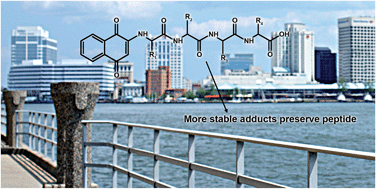Effect of Michael adduction on peptide preservation in natural waters†
Abstract
The reaction of peptides with chemicals already present in natural waters (such as polycyclic aromatic hydrocarbons) is one method that has been suggested to preserve peptides for the longer term. In this study we test whether the reaction of tetrapeptides with a model quinone can help stabilise the peptide in one polluted riverine system, Elizabeth River in Virginia, USA. We found that there is almost no difference in rate constants between the peptide and its quinone adduct (e.g. 6.62 versus 6.86 per day for AVFA and its respective adduct). However, when monitoring the removal of the adduct from natural water, we identified two new compounds that are formed as a result of its decomposition. Using tandem mass spectrometry we identified potential structures and mechanisms for the formation of these new compounds. These new compounds are more recalcitrant than their parent peptide–quinone adduct, since they remain in solution for 3–10 times longer. Based on our findings we postulate that the reaction of peptides with quinones can help preserve sections of the original peptide following an initial rearrangement of the original adduct, potentially explaining why seemingly labile peptides are observed in most natural waters.

- This article is part of the themed collection: Geoscience (ESPI)

 Please wait while we load your content...
Please wait while we load your content...